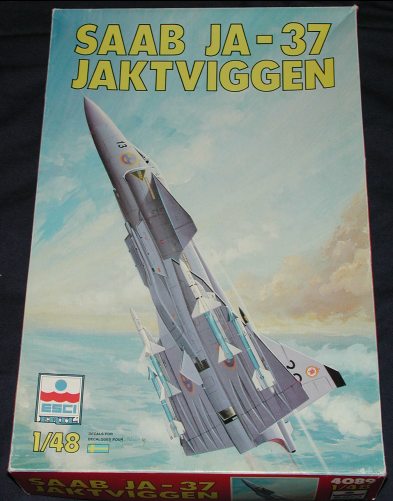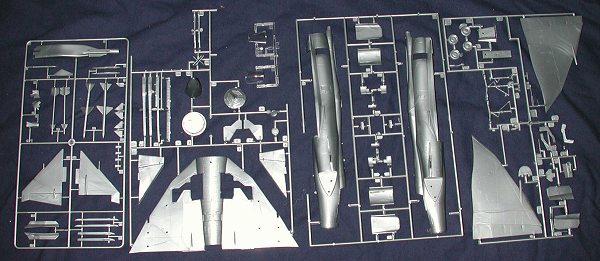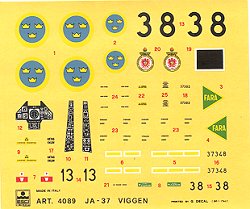
|
KIT: |
ESCI 1/48 JA-37 'Viggen' |
|
KIT # |
4089 |
|
PRICE: |
$ |
|
DECALS: |
One Aircraft |
|
REVIEWER: |
|
|
NOTES: |

|
HISTORY |
The Viggen is a multi-role fighter, through upgrades still
modern and with some almost unique features, in service with the Swedish air
force in several versions, since 1971 and until after 2006. The name Viggen
means The Thunderbolt, especially those resulting from the Norse god
Thor's war-hammer Mjölner.
In 1952 studies were started to design a replacement for Saab Draken. "Project
1357" in 1954, was the first to have a canard layout (lots of other layouts were
studied as well). In 1961, the P&W JT8D-22 was the chosen engine to be
locally built, with a locally designed afterburner and lots of material changes
in the rest. In 1962 the design was frozen, and the prototype first flew in Feb
8th 1967. During the 1960's, it was foreseen that the Swedish air force would
purchase 800+ Viggens, but the final figure ended up at 329. In order to make
the airframe smaller, it was early decided to replace the navigator with a good
navigational computer. It's designed to withstand 12 G, but the limit in
operation is 7 G.
Emergency power is supplied by a ram air turbine just before the left wing
leading edge, which extends automatically on hydraulic power failure, and just
before touch down. (Earlier, it was also always deployed whenever the landing
gear was down.) The canard doesn't contribute much lift in itself during normal
flight, it acts more as a gigantic vortex generator for the main wing. During
low speed flight, its rear edge flap can be lowered to increase lift and permit
a high nose angle.
The requirement was that the aircraft would be able to operate from 500 m
runways. A short take-off run is possible due to the powerful engine (then, it
was the most powerful installed in a fighter). Landing distance is reduced by
several means: The HUD is used as a precision landing aid, making it possible to
aim just 30 m in from the threshold; The landing gear thinks a landing sink rate
of 5 m/s is normal, so landings are done without any flare; The thrust reverser
is interconnected with the nose gear link, so it can be selected in the air and
will operate when the nose is lowered. (It is not intended to be used in the
air.)
The aircraft must be serviceable very quickly by conscripts with relatively
short training. Re-fueling and re-arming by 7 men, of which 6 are conscripts,
must take less than 10 min for the JA 37 Viggen. The time limits for
reconnaissance and attack configured aircraft are 15 and 20 minutes. It is said
that attack squadrons expect to fly 11 missions per aircraft durin a 24-hour
period.
Of the JA.37, 149 were delivered between 1979 and 1990,
and will remain in service until 2010-15. Serial numbers 37301-37449. By the
time this version was in final design, it was clear that guns were definitely
useful, so it was given the most powerful cannon a fighter has had, a 30 mm
Oerlikon KCA with 150 rounds. Rate of fire is 22.5 0.36 kg rounds/s at 1050 m/s,
which gives them six times more kinetic energy than the 30 mm Adens on the
attack version. A unique feature is the coupling of the radar gunsight mode to
the autopilot. When the pilot places a target in a capture window, the autopilot
takes over pitch and yaw, and presents bank information on the HUD for the pilot
to follow. Even if it's not followed, the pitch and yaw channels have enough
authority to precision aim the cannon, reducing pilot workload letting him or
her concentrate on tactics and situational awareness. The fighter version has an
inertial navigation system instead of the earlier versions' Doppler navigation
system. It is 13 cm longer, partly because the RM8B engine, which is smokeless,
more powerful and better suited to high altitude than the RM8A which powers the
other Viggen versions, is 8 cm longer than the RM8A. There is a three stage fan,
three stage LP compressor and a seven stage HP compressor, as compared to 2/4/7
on RM8A.
The fin is the same tall one as on Sk 37 to compensate for the longer fuselage.
The external tank is the same size as on the other versions, but because there's
a bulge where the gun is installed, there is no room for the abbreviated top fin
of the tank, instead of three fins, this tank has four fins, in a flattened 'X'.
The system has gone through numerous upgrades since service entry. The radar is
able to track more targets now, than at service entry, for example. The latest
software upgrade, EDIT 33, enables the JA 37 to use AMRAAM missiles. In spite of
having a strengthened wing, an engine 100 kg heavier (2200 kg) and a fixed
cannon, it only has an empty weight 400 kg more than earlier versions. In
service it has replaced and supplemented the J 35 Draken.
|
THE KIT |

The kit is very typical of early ESCI kits. What I mean is that all the panel lines and other detailing is of the raised variety instead of engraved as was the case with later molds. Generally, the detailing is quite good, however, I found a number of rather nasty sink marks, especially on the aft section of the fuselage where the plastic is thick. This unfortunate trait was carried on to a number of other parts of the aircraft. I also found quite a few ejector pin marks in most unwanted places, such as landing gear struts and wheel hubs. This kit will require filler and clean-up to an extent that may put some people off. Not that it is like many short run kits, just that you need to be aware of these problems and take care of them.
 The rest of the detail work is fairly good, and extends to the wheel wells and
interior. Decals are used for instruments as that was very much in vogue at the
time. Since this is the interceptor version, you'll find that there are
different sprues in this kit as compared to the AJ-37, which is the ground
attack aircraft. Those sprues include the different tail and weapons carried by
the interceptor version. In this case it is the Swedish versions of the Sparrow
and Sidewinder for missiles and a gun pack.
The rest of the detail work is fairly good, and extends to the wheel wells and
interior. Decals are used for instruments as that was very much in vogue at the
time. Since this is the interceptor version, you'll find that there are
different sprues in this kit as compared to the AJ-37, which is the ground
attack aircraft. Those sprues include the different tail and weapons carried by
the interceptor version. In this case it is the Swedish versions of the Sparrow
and Sidewinder for missiles and a gun pack.
Instructions are very good and offer color info in FS 595 numbers as well as a generic name. They also offer what looks to be Humbrol numbers, but since Humbrol changes their numbers from time to time, I'm not sure if what is in the instructions is current. Decals are for one aircraft in overall FS 36373 light grey. More modern Viggins are in a two tone grey scheme that looks very nice.
|
CONCLUSIONS |
Well, if you want a 1/48 Viggen, then this is it. It may be reboxed by other companies, but the base mold is the same.
If you would like your product reviewed fairly and fairly quickly by a site that has well over 175,000 visitors a month, please contact me or see other details in the Note to Contributors.